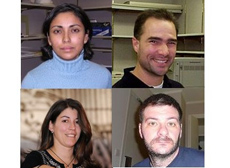Measurement of W spin from CDF top quark decays
 |
| The above diagram shows the top quark at rest and decaying into a W boson and a b quark. In the top quark rest frame, the W boson and b quark move back-to-back, as shown by the yellow arrows. This image also shows the directions of spin for the top quark (green arrow), b quark (blue arrow) and W boson (red arrow) for three different spin states of W boson. A more technical plot is available here. |
At the Tevatron, top quarks are predominantly produced
with an anti-quark.
In the Standard Model, all other quarks produced in collisions first combine with one another to form bound states before decaying to lighter quarks or interacting in the detector. This complicates scientists' study of the quarks' properties.
However, as a result of its large mass, the top quark's lifetime is a trillionth of a trillionth of a second. This provides us with a clean way to test the Standard Model and to probe for possible new physics.
The idea of spin is familiar. A common example is that of the Earth, which rotates about an axis tilted 23.5 degrees. The tilt of the Earth's rotation is responsible for the four seasons. Determining the direction of the spin is important both on our scale and also on the scale of particle physics. Measuring the properties of the W boson resulting from top quark decay, such as spin, allows us to test the theoretical predictions of quantum mechanics and particle physics. The spin of the W is defined as the orientation of its spin axis, or vector, in relation to its direction of motion.
The spin of the W is restricted by quantum mechanics and can only take a set of discrete values relative to its direction of motion: right-handed, left-handed or longitudinal (in the direction of motion).
In the Standard Model theory the fraction of events with right-handed spin (f+) is almost zero while the fraction of events with longitudinal spin (f0) is about 70 percent. If they exist, new particles or new forces
might make the fraction of longitudinal and right-handed events significantly different from the Standard Model expectation.
CDF has adapted a powerful analysis technique originally used to precisely determine the top-quark mass (Fermilab Today for Aug. 10, 2006) to instead determine these W spin fractions in events containing both a top quark and anti-top quark pair.
This technique allows us to make more precise measurements in comparison to other analyses for this measurement.
From a sample of 828 candidate events CDF determines using a model independent fit to the data.
f0 = 0.879 with an uncertainty of ± 0.123,
f+ = -0.151 with an uncertainty of ± 0.088.
This result, recently published in Physical Review Letters, is based on 2.7 inverse fentobarns of CDF data. It is the most precise measurement of the longitudinal spin so far and agrees with expectations for the Standard Model.
More information
-- Edited by Andy Beretvas and GP Yeh
 |
Front row from left: Mousumi Datta and Douglas Glenzinski, Fermilab. Second row from left: Florencia Canelli, University of Chicago and Fermilab; and Ricardo Eusebi, Texas A&M. |
|